
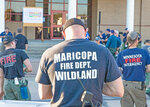
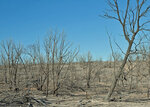
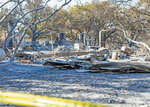
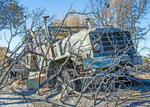

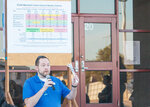
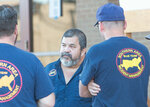
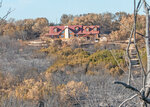
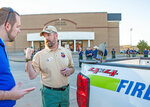
Even in the beginning of its mop-up stage, the Chalk Mountain fire is the priority blaze in Texas because of its proximity to power transmission lines coming from the Comanche Peak Power Plant in Glen Rose.
Firefighters from 35 different states and one from the Commonwealth of Puerto Rico are still patrolling the backroads of northern Somervell and southern Hood counties. They continue to battle hot spots and make decisions about the possibility of burning out an area that still contains brush and trees that could cause a re-ignition of the fire that has burned more than 6,500 acres.
Some areas have been devastated.
A fire-created moonscape flanks a road between the Loco Coyote Grill and FM 205. Everything is burnt. There's not a single blade of grass anywhere for miles. The trees are burnt to a crisp, and the ground puffs up in small black ash clouds when walked upon.
From the air, the blaze's path looks ironically like a three-toed dinosaur track (Dinosaur Valley State Park is nearby), and dinosaurs didn't care where they stepped or what they destroyed.
There are stories where the flames kissed people's front porches but left their homes intact. Some were out-and-out true miracles, and the others were helped by the technology of the National Weather Service and incident meteorologists like Kurt Van Speybroreck and his trainee, Glen Kendrick.
From predicting potential hot spots to 70-mph dust devils – guys like Speybroreck get more than their fair share of scolding about inaccuracy from firefighters. Still, the bottom line is most of the time, he's right, and his predictions can produce life-and-death decisions.
"We try to size up the situation. What size is our air force? How many planes versus helicopters? Where are they? What are they doing? What's the fire doing? How's it behaving? How's the weather affecting the fire? Are there any critical weather patterns that will come in and either cause a major run or an explosion of the fire?" Speybroreck said.
The idea is to be able to give firefighters a heads-up on what they may expect throughout the day. The forecast can change because a big fire like the Possum Kingdom Complex Fire in 2011 created its own weather, including a hailstorm.
"We probably don't have to worry about too many weather events today," Speybroreck said.
As Speybroreck pulls out his laptop, there's a close-up view of the Chalk Mountain area littered with dots indicating where lightning strikes have occurred.
While the cause of this fire is still under investigation, there was one incident involving a Chalk Mountain resident who called to report his pavilion was on fire. A few days before it ignited, it had been struck by lightning and was burning internally.
When the resident called in for help, the NWS had already provided information that showed the most likely spot for firefighters to launch an attack, and a helicopter was dispatched to douse the flames.
In his 30-plus years working for the NWS, Speybroreck has seen lots of changes and lightning strike technology. Being able to predict hotspots ranks among the most significant.
"We have a group that works with the fire behavior analysts from Texas, Oklahoma, Kansas, and older meteorologists, basically from El Paso up through the plains, to identify patterns we want to watch out for and set the satellites up and say, ‘Hey, we need to look at this area for hotspot detection,’ because sometimes we can actually see the fire before the 911 call comes in," Speybroreck said.
Reducing the time needed to detect a fire makes a big difference.
"I believe satellite detection technology has allowed us to alert volunteer fire departments, county folks, and state folks of potential hotspots so much quicker now. They can get out there and get things taken care of in a matter of hours versus waiting days until someone sees the smoke call," Speybroreck said.
On Wednesday, roughly 100 firefighters gathered around the practice gym steps at Glen Rose High. NWS meteorologist trainee Kendrick got his chance to perform under a bit of pressure, and he presented the day's weather forecast, which is a little more in-depth and detailed than those provided on nightly TV news channels.
The chart behind Kendrick predicts more blazing hot weather with a teasing 20% chance of rain on Saturday tangling in the middle of the chart.
The forecasts are hour-by-hour and include information from formulas developed over decades of recordkeeping and research.
The Chalk Mountain incident commander Mark Morales was among those speaking. Like everyone before and after him, he encouraged the firefighters to remain vigilant and continue to take all safety precautions.
As a veteran firefighter with almost 30 years of experience, Morales has an appreciation for Texas.
"I've been doing this for 29 years and probably been to that many states. It's the first time I've ever seen a hydration station, and the local folks just made it happen. The community support is great here. The local grocery chains, I've worked with them before, and they stepped up again," Morales said.
"I know how good they are. All the local community is just ensuring they're taking care of the firefighters. I mean, that's amazing. And you don't see that just everywhere. It's one of the reasons I love coming to Texas. Anytime Texas A&M Forest Service calls me and requests us to come here, I know that I'm going to be in a good place."
Morales also spoke about the serious nature of the fire in its proximity to Comanche Peak.
"Those transmission lines carry a lot of energy, especially to the metroplex. With this kind of heat, if you were to have disruptions, you would have multiple medical problems because you have some folks that aren't as well adapted. People need power for issues (like) COPD, and there's a lot of different medical issues that require power to help."
Russell@hcnews.com | 817-573-7066 ext. 231